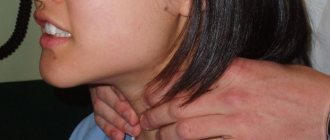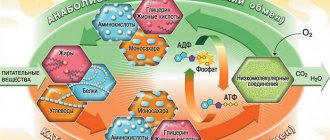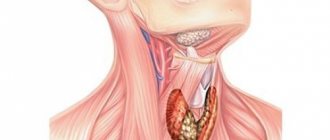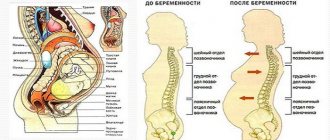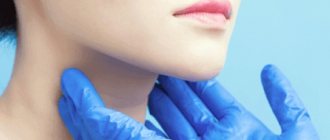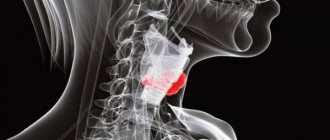Stages of nodular goiter
The degrees of nodular goiter are determined according to Nikolaev’s classification:
- Zero. The thyroid gland is not visible or palpable;
- First. The gland can be felt during examination, but is not yet visible visually;
- Second. The increase is visible when swallowing;
- Third. The neck becomes asymmetrical;
- Fourth. An enlarged goiter apparently deforms the neck;
- Fifth. The thyroid gland compresses the veins and nearby tissues.
There is also a WHO classification. According to this system, grade 1 nodular goiter is accompanied by the growth of the thyroid gland. The diseased organ becomes larger than the terminal phalanx of the first finger. Deformation is determined by palpation. Visible enlargement of the gland at any stage is a grade 2 nodular goiter.
Types of nodular goiter
There are several clinical forms of the disease. There are single-nodular and multinodular, diffuse, colloid, toxic and non-toxic nodular goiter.
Single (solitary) formations most often appear with gland adenoma. The tumor is benign, but produces hormones, so it can degenerate into cancer. Malignant formations can also be represented by dense single nodes from the first stage of development.
Several foci of pathological tissue changes form a multinodular goiter, or conglomerate, which is formed by the connection of small foci.
The diffuse form of the disease is characterized by widespread changes in the thyroid tissue.
Colloid nodular goiter most often develops with age and is associated with chronic iodine deficiency. Gland cells synthesize colloidal thyroglobulin.
To any degree, nodular goiter of the thyroid gland can have a toxic or non-toxic form:
- non-toxic (euthyroidism) – the functional activity of the gland is normal, when examining the patient, a slight enlargement of the organ can be detected, the disease does not manifest itself;
- toxic (thyrotoxicosis) – the proliferation of pathological tissue is accompanied by an increase in hormone levels. The disease is severe, with severe symptoms.
Causes
The following factors contribute to the development of diffuse goiter with nodes:
- Insufficient supply of iodine to the body. The disease can occur when iodine intake is less than 1 mg per day. This trace element is found in seaweed, fish and seafood.
- Monotonous food.
- Genetic disorders.
- Congenital malformations of the thyroid gland.
- Low physical activity.
- Lack of animal proteins in the diet.
- Decreased immunity.
- Excess fluorine and chlorine in drinking water.
- Uncontrolled use of medications.
- Period of hormonal changes (menopause).
- An excess of goitrogenic foods in the menu that contribute to the growth of the gland. These include spinach, cabbage, radishes, turnips and radishes.
- Burdened heredity.
- Metabolic disease.
The development of diffuse goiter with nodules is facilitated by uncontrolled use of medications.
The disease develops in several stages. First, the connective tissue grows (hypertrophy). Then the number of glandular cells increases (hyperplasia). After this, follicles begin to form in the tissues of the organ. These changes are irreversible. At the next stage, multiple nodes appear.
Causes of pathology
The main reasons for the formation of nodular goiter in adults and children:
- genetic changes caused by an environmentally unfavorable environment (increased levels of radiation, pollution with toxic substances, etc.);
- hereditary factor;
- iodine deficiency, as a result of which the gland tissue grows unevenly with the formation of nodes;
- genetic pathologies such as Down syndrome;
- chronic stress;
- traumatic brain injuries;
- atherosclerosis;
- hormonal changes in the body during puberty, pregnancy, menopause; symptoms of nodular goiter in women often occur against the background of uterine fibroids;
- autoimmune diseases;
- infections with a long course;
- taking medications;
- bad habits.
Causes of the disease
Currently, the causes of the disease are not fully understood. But, nevertheless, most often the disease is caused by:
- Decreased or increased levels of hormone production.
- Hereditary predisposition.
- Lack of iodine in the body.
- Deficiency of microelements and vitamins.
- Gene dysfunction.
- Adverse environmental effects, including increased levels of radiation.
- Various stresses and disorders, mostly affecting women.
- Chronic infections and diseases.
- Excessive consumption of alcohol and tobacco.
Symptoms of the disease
Symptoms of grade 1 nodular goiter of the non-toxic form may be absent. As tissue grows, signs of compression of nearby structures appear:
- cough of unknown etiology;
- hoarse voice;
- difficulty swallowing;
- sensation of a foreign body in the throat;
- swelling of neck vessels;
- dyspnea;
- pain on palpation in the case of an inflammatory process or rapid growth of tumors.
As goiter develops, the hormone-producing function of the gland changes. A second group of symptoms appears.
When hormone levels increase (hyperthyroidism):
- tremor of the limbs;
- temperature increase;
- nervousness, sleep disturbances, depression;
- exophthalmos (protrusion of the eyeballs);
- tachycardia, shortness of breath;
- diarrhea;
- sweating;
- heat intolerance;
- weight loss due to increased appetite;
- hair loss.
When hormone levels decrease (hypothyroidism):
- confusion of thoughts;
- hair loss;
- bradycardia, low blood pressure;
- dry skin, brittle nails; ;
- memory impairment;
- constipation;
- sensitivity to cold;
- weakness, fatigue;
- mood swings, anxiety;
- increased blood cholesterol levels;
- joint pain.
One of the symptoms of nodular goiter of the thyroid gland in women may be menstrual irregularities and infertility. Pregnant women may have a miscarriage. Symptoms of nodular goiter in men often include impotence.
Thyroid goiter - symptoms
In the early stages of the development of pathology, it is possible to detect an enlarged thyroid gland either during an ultrasound scan of the organ or by palpation during a physical examination of the patient.
As the disease progresses, structural changes in the thyroid tissue become visible to the naked eye in the form of thickening of the anterior surface of the neck.
If the nodes reach very large sizes, there is a risk of compression of nearby anatomical structures with a characteristic clinical picture.
So, with compression of the trachea and esophagus, the following symptoms appear:
- feeling of a lump in the throat;
- change in voice timbre;
- dysphagia;
- nonproductive cough;
- suffocation;
- hoarseness and sore throat;
- labored breathing.
When overgrown thyroid tissue compresses the cervical neurovascular bundle, signs associated with disturbances of regional hemodynamics arise:
- dizziness;
- weakness;
- discomfort in the neck area;
- noise in ears.
Pain in the node can be caused by its malignancy, the development of inflammation or hemorrhage.
It is worth noting that the functioning of the thyroid gland in nodular goiter is usually not impaired. If the disease is combined with hormonal abnormalities, then, depending on the level of thyroid hormones, symptoms of thyrotoxicosis or hypothyroidism develop.
With hyperthyroidism, patients are concerned about:
- hyperthermia;
- tachycardia;
- nervousness, increased irritability;
- tremor of the limbs;
- exophthalmos;
- hyperhidrosis;
- weight loss;
- increased appetite;
- flatulence;
- diarrhea.
With hypothyroidism, the following symptoms attract attention:
- arrhythmias;
- decreased body temperature;
- overweight;
- decreased libido;
- dysmenorrhea;
- depression;
- fragility of nails;
- baldness;
- swelling of the face, tongue, lips and limbs;
- recurrent miscarriage;
- retardation in mental and physical development of children;
- poor appetite;
- constipation;
- dry skin.
Nodular goiter is not a separate disease, but represents only a preliminary diagnosis, therefore, when it is detected, further examination of the patient is required to make a final medical opinion.
Diagnosis of nodular goiter
At the Alfa Health Center clinic, diagnosis begins with an appointment with an endocrinologist. Based on the results of the examination, the doctor issues referrals for tests, examinations, and consultations with specialists.
History taking
Nodular goiter of the thyroid gland of the 1st degree has no characteristic symptoms. Most often, the disease is diagnosed during a medical examination or targeted examination. The patient independently consults a doctor in case of severe compression syndrome or visible deformation of the neck (grade 2-5). The doctor records the patient’s complaints, finds out the presence of medullary cancer and goiter in the family history, cases of irradiation of the neck and head area, and surgical intervention on the organ.
Physical examination
A physical (clinical) examination includes palpation of the gland, assessment of local signs: neck deformation, hoarseness, dysphagia, etc. The doctor can detect goiter formations larger than 1 cm. At the same time, the lymph nodes are palpated.
Laboratory diagnostics
At the initial stage of the examination, the patient is prescribed a blood test to determine the following indicators:
- Calcitonite. If the level of calcitonitis is high, a stimulation test is additionally performed;
- Thyroid-stimulating hormone (TSH). If the TSH level is reduced, an additional test for free T3 and T4 is prescribed; if the TSH level is elevated, only free T4 is prescribed.
Instrumental diagnostics
- Ultrasound . To diagnose nodular goiter of the thyroid gland of the 1st degree and all subsequent ones, ultrasound examination is recommended. The method allows you to visualize an organ and identify pathological structures in tissues, including those that are not palpable. The main objectives of the study: to determine the indications for FNA (fine-needle aspiration biopsy), to assess the size and shape of regional lymph nodes, to determine the mobility of the vocal folds.
- Biopsy . Differential diagnosis of cancer and benign formations is carried out using FNA. A biopsy is prescribed in the presence of large nodes in the tissues, when changes are detected in the cervical lymph nodes, in patients with a high risk of developing aggressive oncology, as well as for a number of other indications at the discretion of the doctor.
- Cytological examination . Tissue samples obtained from biopsy are sent for cytological examination. The conclusion of specialists will allow the doctor to make a clinical diagnosis.
- Radioisotope scanning . The study is carried out in the presence of manifest or subclinical thyrotoxicosis. The results of radioisotope scanning are used for differential diagnosis of the causes of pathology.
- CT scan . CT scan of the neck and upper mediastinum is indicated to evaluate tracheal compression syndrome. The procedure is carried out to diagnose nodular goiter with a retrosternal location, with large and multiple formations.
Diagnostics
If the thyroid gland is enlarged and there are clinical signs of goiter, you need to contact an endocrinologist and be examined.
Differential diagnosis is carried out with diffuse endemic goiter, Graves' disease (Graves' disease, diffuse toxic goiter), malignant tumors and thyroiditis (acute, subacute, chronic autoimmune).
To make a diagnosis you will need:
- Ultrasound;
- radioisotope scanning;
- CT or MRI;
- general clinical blood and urine tests;
- blood chemistry;
- neck palpation;
- interviewing the patient;
- visual inspection;
- blood test for hormones (thyroxine, triiodothyronine, thyroid-stimulating hormone of the pituitary gland);
- antibody test.
To make a diagnosis you will need to take a biochemical blood test.
Determined by the severity of the goiter. At grade 1, it is not visible, but is determined only by instrumental examination. The volume of the gland reaches 30 cm³. In grade 2, goiter and nodes are detected during palpation, and in grade 3, the goiter is visible to the naked eye.
Treatment of nodular goiter
The disease in its early stages does not require drug treatment. For nodular goiter of the thyroid gland of degrees 1 and 0 (no pronounced symptoms), dynamic observation by an endocrinologist is recommended, monitoring the TSH level and ultrasound at least once a year.
For patients at risk with formations less than 1 cm and suspicious ultrasound signs, treatment tactics are determined according to the Bethesda classification. If there is a high probability of malignancy, thyroidectomy is performed.
Patients with benign tumors at high surgical risk are prescribed treatment with radioactive iodine.
In cases of severe disease, thyroidectomy is indicated.
Treatment
Therapeutic tactics are determined by the patient’s condition and the level of thyroid hormones. Most often, conservative therapy is performed. Treatment methods for this pathology are:
- Use of medications. In case of development of hypothyroidism, iodine preparations (Iodomarin) and Eutirox are prescribed. For symptoms of hyperthyroidism, thyreostatics (Mercazolil, Tyrozol) are indicated. The choice of hormonal and iodine-containing drugs is made by the doctor, taking into account their tolerability by the patient. If necessary, the dose is gradually reduced. Additionally, symptomatic medications are used. Many medications are taken half an hour before meals.
- Use of radioactive iodine. It is an alternative to surgery.
- Operation. Indicated in cases of severe compression syndrome, ineffectiveness of medications and the development of dangerous complications. Subtotal resection of the organ, enucleation of nodes and removal of the affected lobe of the thyroid gland can be performed. The operation to remove nodes requires preliminary anesthesia or general anesthesia.


